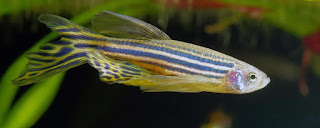Zebrafish Care and Experimental Techniques: In Situ Hybridization - Zebrafish Sections

**Day 0: Goals: To preserve zebrafish and obtain sections using the cryostat. **Everything used on this day needs to be RNase free . Wear gloves and be sure to use only PBS that has been treated with DEPC. 1. Anesthetize zebrafish 2. Fix in freshly thawed BT fix for 3 hours at room temperature. Keep solution on the "belly dancer" so that it is constantly moving. 3. Rinse 3 x 5 minutes in 1X PBS. Leave embryos in pbs until you are ready to section them. Embryos can be stored in the fridge until sectioning, but keep the days between fixing, sectioning and staining as short as possible. 4. Rinse fish in 30% sucrose and PBS until embryos sink approx. 30mins. 5. Trnsfer embryos from sucrose to plastic molds, 5 fish pre mold, with heads facing the side with writing. Absorb as much sucrose as possible. 6. Add OCT to the mold, and swirl fish until they are oriented correctly. Freeze in -80 degree freezer. 7. Follow instructions for sectioning using the cy